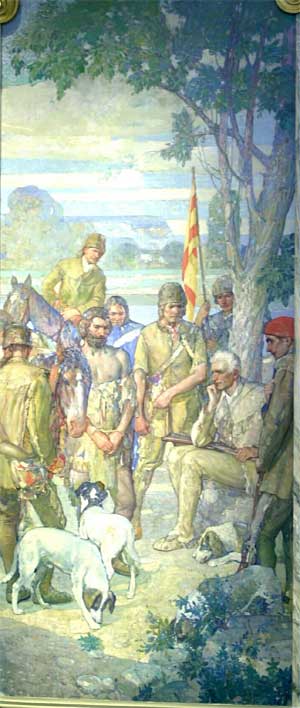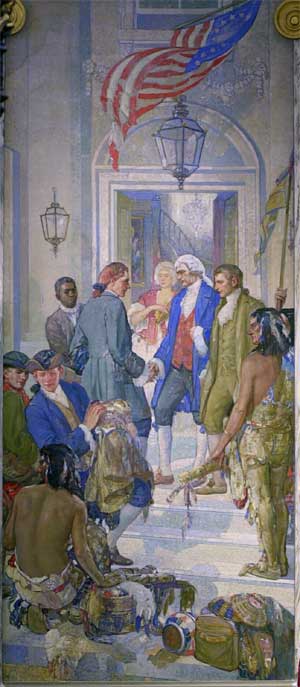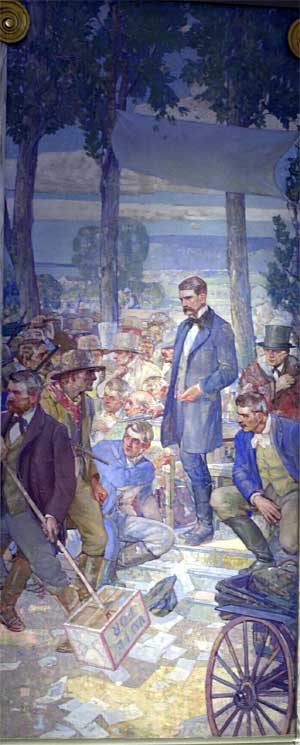|
Daniel Boone at the Judgment Tree
The Colonial Period
This mural represents the colonial period of Missouri. Daniel Boone is seated at the base of the famous Judgment Tree, with his gun across his knees. He is watching the accusers who have brought a culprit before him, a man with hands bound. Boone held the position of Syndic, or Commandant of the Femme Osage District, Missouri being under Spanish rule. Note the Spanish flag in the background. He was vested with the entitlement of judge, jury and sheriff, and could order the guilty party whipped, banished or killed. Historical accounts say his decisions were widely accepted as fair.
During the colonial period, Missouri had three classes of people: the Indians, the French adventurers and the traders, who lived on good terms with the Indians. Boone was regarded as a brave pioneer and hunter. He came to Missouri in 1799 at the request of Zenon Trudeau, the Spanish governor of St. Louis. Boone accepted a grant of land on the Femme Osage River west of St. Charles. The earliest explorers earned their keep by hunting deer, bear and beaver. Beaver skins were especially valuable because the fur was shipped to Europe and made into top hats — the day's fashion for the wealthy. As they hunted, the explorers made maps of the land and noted resources for the families who would follow.
Boone influenced many to migrate to Missouri, and is given credit for turning Missouri into the Mother of the West. When he died in 1820, the territory had passed into statehood, and the State Legislature adjourned for a day in his honor.
Daniel Boone was a man who truly loved Missouri.
|
 |
Jefferson greeting Lewis and Clark
The Territorial Period
This mural represents the territorial period in Missouri history. President Thomas Jefferson commissioned Meriwether Lewis and William Clark to explore the Louisiana Territory soon after buying the expanse of land from France for $15 million in 1803. The land we now know as Missouri, acquired by the United States in the Louisiana Purchase, became the 24th state when admitted to the Union in 1821.
The painting depicts Jefferson on the porch of the White House after Lewis and Clark returned from exploring the Louisiana Territories. (Jefferson is shaking Clark's hand, Lewis stands to the right.) The pair had begun their great expedition in 1804, departing St. Louis. They recorded every step of their journey to the Pacific before returning almost two years later. They went on to Washington to report their findings to Jefferson. This was the first time Jefferson had met Clark; Lewis had formerly been Jefferson's secretary. Both men were later appointed as statesmen for the land that is now Missouri.
The other people shown in the painting are friends and servants to the President and companions of the explorers. Indians are shown with products of the Great West. Lewis and Clark became famous for exploring the new American land and her vast natural resources.
|
 |
Blair's Speech at Louisiana, Missouri
The Civil War Era
The mural depicts Francis P. Blair, who is credited with keeping Missouri in the Union during the Civil War. He was a Union general and fought for the Union throughout the Civil War. When Grant was asked to name his bravest and most efficient fighting generals, he named Blair and General John A. Logan. (Logan served in the U.S. Congress after the war, and is famous as the founder of Memorial Day.)
In 1865 the “Drake Constitution” was adopted in Missouri, stating that before a man could vote in this state, he had to take an oath swearing that he had not given aid or comfort to the Confederate cause.
General Blair made a statewide canvass as he campaigned for a U.S. Senate seat. Blair’s first Democratic speech was to be given in Louisiana, Missouri. Blair was sent word that he would be assassinated upon his arrival, but arrived in Louisiana in spite of the threats. Upon taking the platform, he unbuckled his holster and laid two pistols in front of him. “I understand that I am to be shot if I speak here today,” he said. “Perhaps we would better attend to this ceremony now.” No attempt was made to kill him. When he began to speak a red faced fellow in the audience jumped up and shouted, “He’s a damned rebel. Throw him out.” Pointing his finger at the man, Blair shouted back, “You come and throw me out!” This is the confrontation depicted in the mural. Blair’s commanding presence held the crowd in check; he finished his speech, and carried his campaign on into Moberly, Marshall and Warrensburg.
Historically, Blair well represents Missouri in the Civil War era. When the White House asked Missouri to name two of her greatest sons to be placed in Statuary Hall in Washington, the unanimous vote was for Thomas H. Benton and Frank P. Blair.
|
 |
Benton's Speech at St. Louis
The Era of Westward Expansion
This mural represents the period of westward expansion of Missouri — the gateway to the west. Senator Thomas H. Benton was known for constantly predicting the great future of the West. For several years, he tried to persuade Congress to appropriate funds to build a railroad from St. Louis to the Pacific. The eastern states' delegation argued the West was merely a land of deserts and savages, but Benton continued to rally for his cause.
Benton was also known for the length of his speeches, and is shown here addressing a mass gathering in the St. Louis Courthouse in 1849. On the platform behind him are seated Mayor John M. Drum and Stephen A. Douglas. Douglas, an Illinois Congressman, is known for sponsoring the Kansas-Nebraska Act in 1854, which popularized the idea of popular sovereignty. He is also credited with making Chicago a major railroad hub of the Midwest.
Isaac H. Sturgeon is shown with a tall hat in the audience at Benton's left. Sturgeon was the first president of the North Missouri Railroad, or Wabash. The man with sideburns is Thomas Allen, second president of the Pacific Railroad. The man to his right is John O'Fallon, the first president of the Pacific Railroad.
Critics and historians have been impressed with the composition of this mural in comparison with the other three because of the skill with which the artist filled the disproportionate canvas, a section of wall 19 feet high, but only eight feet wide. It is with great precision that Miller shows Benton upon the completion of his famous address, conveying the opposition of the crowd and the confidence of the speaker. Sen. Thomas H. Benton was the great-uncle of Thomas Hart Benton, who later painted the famous murals in the Missouri Capitol's House Lounge.
|
 |
|
|